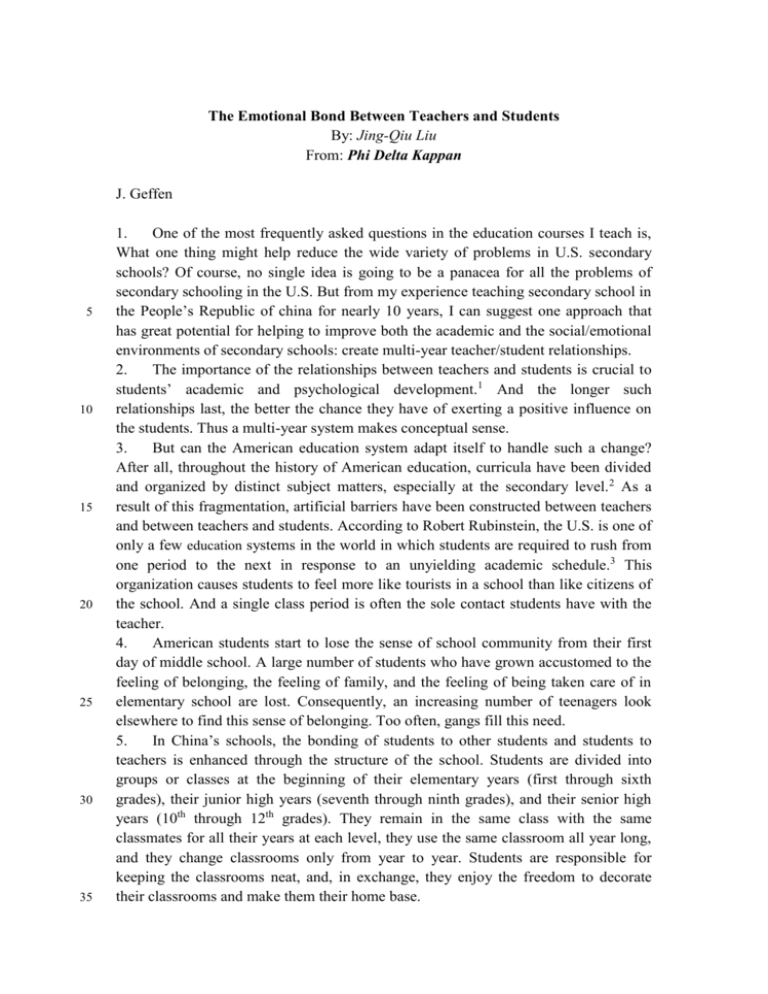Default Normal Template
advertisement

The Emotional Bond Between Teachers and Students By: Jing-Qiu Liu From: Phi Delta Kappan J. Geffen 5 10 15 20 25 30 35 1. One of the most frequently asked questions in the education courses I teach is, What one thing might help reduce the wide variety of problems in U.S. secondary schools? Of course, no single idea is going to be a panacea for all the problems of secondary schooling in the U.S. But from my experience teaching secondary school in the People’s Republic of china for nearly 10 years, I can suggest one approach that has great potential for helping to improve both the academic and the social/emotional environments of secondary schools: create multi-year teacher/student relationships. 2. The importance of the relationships between teachers and students is crucial to students’ academic and psychological development.1 And the longer such relationships last, the better the chance they have of exerting a positive influence on the students. Thus a multi-year system makes conceptual sense. 3. But can the American education system adapt itself to handle such a change? After all, throughout the history of American education, curricula have been divided and organized by distinct subject matters, especially at the secondary level. 2 As a result of this fragmentation, artificial barriers have been constructed between teachers and between teachers and students. According to Robert Rubinstein, the U.S. is one of only a few education systems in the world in which students are required to rush from one period to the next in response to an unyielding academic schedule.3 This organization causes students to feel more like tourists in a school than like citizens of the school. And a single class period is often the sole contact students have with the teacher. 4. American students start to lose the sense of school community from their first day of middle school. A large number of students who have grown accustomed to the feeling of belonging, the feeling of family, and the feeling of being taken care of in elementary school are lost. Consequently, an increasing number of teenagers look elsewhere to find this sense of belonging. Too often, gangs fill this need. 5. In China’s schools, the bonding of students to other students and students to teachers is enhanced through the structure of the school. Students are divided into groups or classes at the beginning of their elementary years (first through sixth grades), their junior high years (seventh through ninth grades), and their senior high years (10th through 12th grades). They remain in the same class with the same classmates for all their years at each level, they use the same classroom all year long, and they change classrooms only from year to year. Students are responsible for keeping the classrooms neat, and, in exchange, they enjoy the freedom to decorate their classrooms and make them their home base. The Emotional Bond Between Teachers and Students / 2 40 45 50 55 60 65 70 75 6. Years of learning together help students form lasting relationships with many of their classmates. Observations in Chinese schools reveal that many students use their classroom as a gathering place before and after school because they feel that the physical setting belongs to them. 7. For faculty members in secondary schools, two types of structures exist. One is a subject-driven departmentalized structure in which faculty members are organized according to their academic disciplines. The other is a student-oriented structure in which faculty members who teach the same grade share the same office and form grade-level groups. In both cases, the people who rush through the halls are teachers, hurrying from their offices to classrooms. Organization by grade is more widely practiced, and faculty members often prefer to remain in their grade groupings for the entire three years of junior or senior high school. In addition to helping with students’ personal development, such an arrangement offers academic benefits for both faculty members and students. 8. The multi-year commitment gives teachers a great degree of academic autonomy, but it also brings with it accountability for results. Both students and administrators assess teachers’ efforts to achieve the prescribed goals and objectives. In addition, teachers’ competence in the subject taught is evaluated in terms of student scores on districtwide tests. 9. Three years of continuous teaching of the same group of students facilitates the teaching and learning of a subject, helps ease the movement from one grade to another, and makes long-term planning easier and more effective. Teachers design a series of master goals in a subject area to be accomplished in the three-year period. Students who may have lagged in achievement in previous years have an opportunity to catch up. With such a deliberately designed plan, even low-achieving students have exhibited amazing progress. Some have been able to move to high ranks of academic performance and have even won admission to a university. 10. A key person in the multi-year structure of Chinese schools is the homeroom teacher. This teacher plays many roles, from instructor to counselor to friend. A homeroom teacher is assigned to a class of 40 to 50 students, usually for two or three years at the elementary level or for three years at the secondary level. The homeroom teacher collaborates with other teachers by supervising the problems and progress of students in his or her homeroom. Moreover, when students are grouped by grade level, their teachers have an automatic communication channel since they teach the same students and share the same office space. 11. The emotional bond between teachers and students that multi-year relationships can foster is also important to students’ development. The frequent contact over three years between students and their homeroom teacher builds mutual trust. Students take their teachers into their confidence and discuss both academic concerns and personal issues. Because homeroom teachers make a heavy commitment to the overall growth of their students, their teaching loads are normally one course less than those of other The Emotional Bond Between Teachers and Students / 3 80 85 90 95 100 105 teachers. In addition, many schools offer extra pay to encourage teachers to volunteer for homeroom responsibility. 12. Teachers in American schools are generally assigned more classes to teach than their Chinese counterparts, though the U.S. classes tend to be smaller. When I was teaching in China, the normal class size was 50 students, and this remains true in Chinese schools today. In China, each teacher would teach only three or four classes a day, however, so the total number of students taught was roughly equal to that of an American secondary teacher. Homeroom responsibilities were a part of this assignment. As a homeroom teacher, I worked with students in diagnosing their academic problems, addressing discipline problems that occurred in any teacher’s class, and making home visits. These activities helped me to gain a more comprehensive understanding of the students’ performance in school. Homeroom teachers came to school 30 minutes earlier each morning and stayed at school later than those who were not homeroom teachers. The greatest reward for such an exhausting commitment was witnessing the growth and progress of students over a three-year period. It was always gratifying to visit with my students later in life and to see them as successful, productive adults. 13. From my personal experiences in China’s secondary schools, I can say that multi-year teacher/student relationships benefited the majority of the students. The close emotional bond between teachers and students led students to recognize the school as a home away from home. The teachers’ dedication to students’ growth helped inspire students to meet the school’s requirements, both academic and behavioral. 14. Schools are microcosms of the societies that create them, and the dominant social values that prevail in a society will prevail in its schools. Individualism is deeply embedded in American culture, and Americans fiercely guard their privacy. Thus American teachers generally cannot get as involved as Chinese teachers do in personal and family problems that might affect their students’ performance. Because of such societal differences, the creation of multi-year student/teacher relationships in America could not simply involve copying the Chinese model that I have described above. However, the obvious benefits that the Chinese system has yielded should encourage American teachers to experiment with a variety of ways to set up multi-year student/teacher relationships. The Emotional Bond Between Teachers and Students / 4 Answer in your own words. Answer the question below in English. 1. What unique advantage does the writer of this article enjoy? Answer : ____________________________________________________________ Answer the question below in English. 2. What aspect of the educational process does the writer emphasize? Answer : ____________________________________________________________ 3. Answer the question below in English. At what stage in their schooling do American youngsters lose their sense of belonging? Answer : ____________________________________________________________ Answer the question below in English. 4. In what crucial respect – paragraph 5 – do Chinese schools differ from American post-elementary schools? Answer : ____________________________________________________________ Answer the question below in Hebrew. 5. Describe the choices available – paragraph 7 – to secondary school teachers in China. Answer : ____________________________________________________________ Answer the question below in Hebrew. 6. Describe the advantages accruing to teachers and students from a multi-year commitment – paragraphs 8-9 – on the one hand, and the responsibilities that follow from it on the other hand. Answer : ____________________________________________________________ The Emotional Bond Between Teachers and Students / 5 7. 8. Answer the question below in English. Describe the functions of the homeroom teacher – paragraphs 10-11; name his equivalent in the Israeli system. Answer : ____________________________________________________________ Answer the question below in English. What makes the homeroom teacher’s job – paragraph 12 – rewarding? Answer : ____________________________________________________________ Answer the question below in Hebrew. 9. What would make it almost impossible – paragraph 14 – for the American educational system to adopt the Chinese model? Answer : ____________________________________________________________










